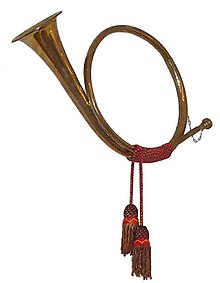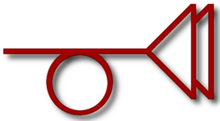Post horn




The post horn (also posthorn, post-horn, or coach horn) is a valveless cylindrical brass or copper instrument with cupped mouthpiece, used to signal the arrival or departure of a post rider or mail coach. It was used especially by postilions of the 18th and 19th centuries.
The instrument commonly had a circular or coiled shape with three turns of the tubing, though sometimes it was straight. It is therefore an example of a natural horn. The cornet was developed from the post horn by adding valves.[1]
Mozart, Mahler, and others incorporated the instrument into their orchestras for certain pieces. On such occasions, the orchestra's horn player usually plays the instrument. One example of post horn use in modern classical music is the famous off-stage solo in Mahler's Third Symphony. Due to the scarcity of this instrument, however, music written for it is usually played on a trumpet or flugelhorn.
In 1844, the German cornet player Hermann Koenig wrote Post Horn Galop (Post Horn Gallop) as a solo for post horn with orchestral accompaniment.[2] In the 20th century it became a popular piece for brass bands.[3] During World War I wooden post-horns were used as a means of collecting war donations via a method called the Nail Men. People would donate and in exchange be allowed to hammer a nail into the horn, until the horn was completely covered.
The instrument is still used as the logo of national post services in many countries.
List of postal services that include the post horn in their logos
This article is missing information about Error: you must specify what information is missing.. (August 2009) |
- Australia Post (Australia)
- Deutsche Post (Germany)
- Česká pošta (Czech Republic)
- Slovenská pošta (Slovakia)
- Belgian Post Group (Belgium)
- P&TLuxembourg (Luxembourg)
- Österreichische Post (Austria)
- Correos (Spain)
- Magyar Posta (Hungary)
- Hrvatska pošta (Croatia)
- Pošta Slovenije (Slovenia)
- Poczta Polska (Poland)
- Lietuvos paštas (Lithuania)
- Eesti Post (Estonia)
- Post Danmark (Denmark)
- Posten Norge (Norway) - previous logo
- Posten AB (Sweden)
- Íslandspóstur (Iceland)
- Postverk Føroya (Faroe Islands)
- Poşta Română (Romania)
- Bulgarian Posts (Bulgaria)
- Posta Shqiptare (Albania)
- Makedonska Pošta (Macedonia)
- PTT (Turkey) (Turkey)
- Poşta Moldovei (Moldova)
- Ukrposhta (Ukraine)
- Belpochta (Belarus)
- Cyprus Postal Services (Cyprus)
- CTT (Portugal) - features a rider on horseback carrying a differently-designed horn
- MaltaPost (Malta) - features a horn with a Maltese cross in the Middle
See also
- Horn (instrument)
- Little Post Horn Squid
- The Crying of Lot 49, by Thomas Pynchon
- Postage stamps and postal history of Germany
- Postage stamps and postal history of Norway
- Serenade No. 9 (Mozart), the "Posthorn" serenade
Notes
- ^ Curt Sachs, The History of Musical Instruments (New York: W. W. Norton & Company, Inc., 1940), 428.
- ^ The Posthorn Gallop, Entry in "The Concise Oxford Dictionary of Music", 4th edn., Kennedy (ed.), Oxford University Press.
- ^ Taylor, Arthur (1983). Labour and love: an oral history of the brass band movement. Elm Tree Books.
External links
- Post horn calls. Hungarian Post Co. Links to sound files.
- The Sound of Post Horns - Strains from a Past Era - Museumsposten - © Post & Tele Museum, Denmark.
